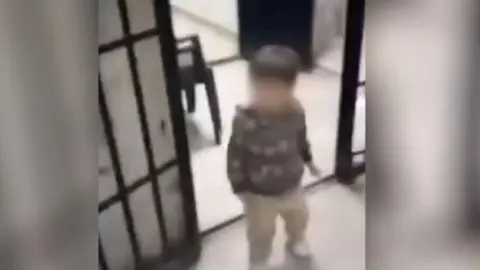Investigated reports of people trapped underground in Syydnaya prison

The Syrian security group known as the White Helmets says it is investigating reports from survivors of the notorious Saydnaya prison that people are being held in secret cells.
Writing in X, the group says it has deployed five “emergency teams” in the prison, assisted by a guide who knows the structure of the prison well.
Saydnaya is one of the prisons that have been liberated since the rebels took control of the country.
Authorities in Damascus province reported that efforts were underway to free the prisoners, some of whom were “almost dead” from lack of air.
The Damascus Countryside Governorate appealed on social media to former soldiers and prison staff of Bashar al-Assad’s government to provide the rebel forces with the codes of the underground entrances.
They said they failed to open them to free “more than 100,000 prisoners seen on CCTV monitors”.
Video has been circulating online and through news outlets including Al Jazeera of what appears to be an attempt to access the lower reaches of the prison.
In it, a man can be seen using a type of post to pull out a low wall, revealing a dark space behind.
Other images show prisoners being released – including a young child being held with his mother. She is featured in a video of the released women posted by the Turkey-based Association of Detainees and The Missing in Sednaya Prison (ADMSP).
“He [Assad] you have fallen. Don’t be afraid,” said a voice in the video, apparently trying to reassure the women that they are now safe.
A video confirmed by AFP shows Syrians rushing to check if their relatives are among those released from Saydnaya, where thousands of opposition supporters are said to have been tortured and killed under the Assad regime.
Rebel forces have swept across Syria, freeing prisoners from government prisons as they go.
Throughout the civil war, which began in 2011, government forces kept hundreds of thousands of people in camps, where human rights groups say torture was common.
On Saturday, the Islamic terrorist group Hayat Tahrir al-Sham (HTS) said it had freed more than 3,500 prisoners from the Homs Military Prison when the group took over the city.
This group was founded in 2012 under the name al-Nusra Front. It was affiliated with al-Qaeda but later severed ties – although the US, UK and a number of other countries continue to see it as a subsidiary of the jihadist movement.
In 2016, the group took its current name of HTS and was later merged with other rebels. It is of particular importance to several opposition groups involved in the recent attacks.
As the rebels entered the capital early on Sunday, HTS announced “the end of the dictatorship era in Saydnaya prison”, which has become the name of the worst abuse of the Assad era.
In the 2022 report, ADMSP said Saydnaya “became a death camp” after the start of the civil war.
It is estimated that more than 30,000 prisoners were killed or died from torture, lack of medical care or starvation between 2011 and 2018. Citing accounts from several released prisoners, at least another 500 prisoners were killed between 2018 and 2021, it said.
In 2017, Amnesty International described Saydnaya as a “house of killing people”in a report that says the massacre was authorized at the highest levels of the Assad government.
At the time the government dismissed Amnesty’s claims as “baseless” and “untrue”, insisting that all executions in Syria followed due process.
 ADMSP
ADMSPA video cited by Reuters shows rebels shooting the lock on the gate of Saydnaya prison and using multiple guns to open the closed doors to the cells. Men poured into the corridors.
Other images, which the Reuters news agency said were taken from the streets of Damascus, appear to show recently released prisoners walking down a street.
In it, a person asks a passer-by what happened.
“We have overthrown the kingdom,” they replied, making the former prisoner laugh.
Of all the signs of the repressive nature of the Assad regime, the network of prisons where those who express any kind of opposition disappear cast a long and dark shadow.
In Saydnaya, torture, sexual abuse and mass murder were the fate of thousands. Many have never resurfaced, and their families often do not know for many years whether they are alive or dead.
One of those who survived this ordeal, Omar al-Shogre, told the BBC on Sunday about what he endured during the three years he was imprisoned as a child.
“I know the pain, I know the loneliness and the despair you have because the world let you suffer and did nothing about it,” he said.
“They forced my cousin whom I loved very much to torture me, they forced me to torture him. Otherwise we will both be killed.”
 ADMSP
ADMSPThe Syrian Network for Human Rights estimates that more than 130,000 people have been detained in these conditions since 2011. But the history of these deliberately terrifying institutions goes back a long way.
Even in neighboring Lebanon, the fear of disappearing into the Syrian abyss was rife during the many years Damascus was a powerful foreign power.
The deep hatred of the Assad regime – both father and son – that lived underground in Syria was due in large part to this industrialized system of torture, death and humiliation aimed at scaring the public into submission.
For that reason, the rebel groups in their lightning drive through Syria to overthrow President Assad made sure that in each city they took hostages to the central prison of each place and freed the thousands held there.
The image of these people emerging from the darkness that has shrouded others for decades will be one of the defining images of the fall of the Assad dynasty.
Source link





